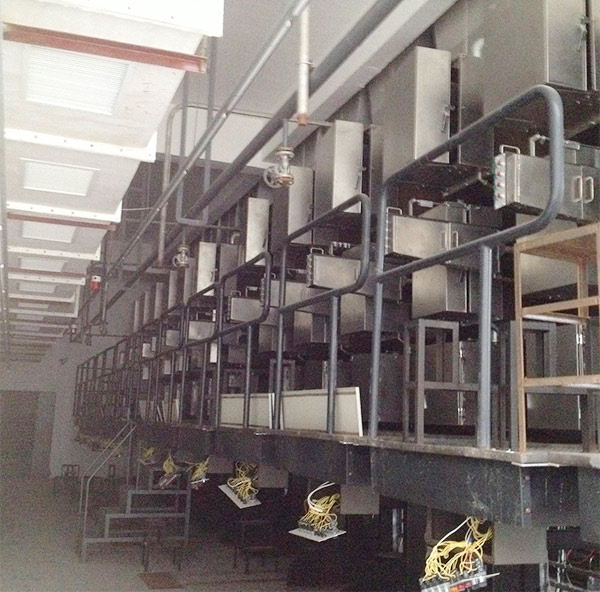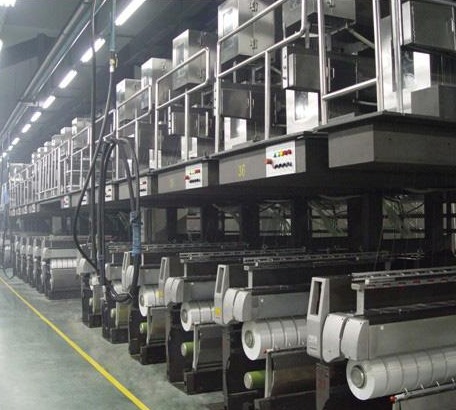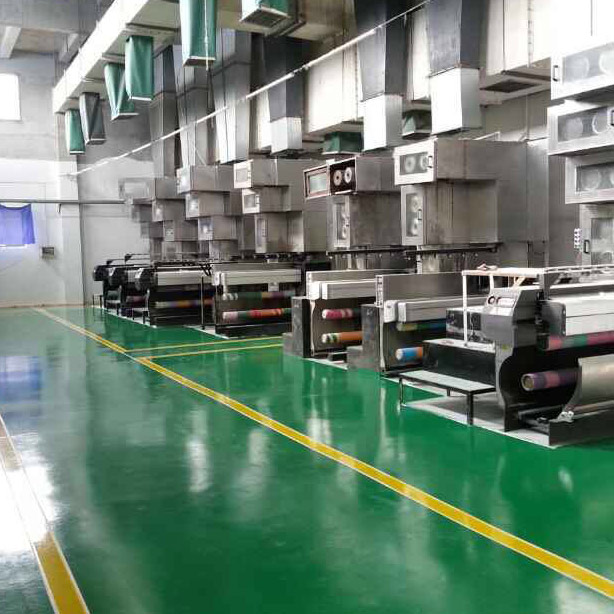- Polypropylene spinning machine
- Polypropylene FDY equipment
- Polyester POY spinning machine
- Polyamide FDY common and high strength equipment
- Polyester FDY equipment
- Polyester high strength equipment
- polyester、Polyamide、 Polypropylene BCF equipment
- Small spinning machine
- All kinds of spinning special parts
- Fubon 2024 wonderful review | Dragon Teng four seas family music, snake dance Kyushu everywhere new, I wish you all the best, accompanied by good luck!
- Textile industry alarm sound | EU sanctions escalation, trade winter is coming, how to break through the textile industry?
- China Shaoxing Textile industry new quality productivity development Forum was held
- Polypropylene spinning machine is the pioneer of excellence in the field of chemical fiber manufacturing
- Management methods | As new managers face many challenges with their changing roles, managers must learn strategies not to detente

- Contact:Mr. Huang Guofu
- Cel:0086-13901505556
- Fax:0086-519-83341119
- Email:czfb5556@126.com
- Add:No. 288-8 ChangLi Rd, Huangli Town, Changzhou, JS PRV.
The first half of this year was a difficult period for the textile and apparel industry.
According to the National Bureau of Statistics, the total retail sales of textiles and apparel from January to July was 595.9 billion yuan, a year-on-year decrease of 17.5%, which was 7.6 percentage points lower than the growth rate of retail sales of consumer goods in the same period.
This also fully shows that, compared with rigid demand products such as food and household appliances, the textile and apparel industry lacks rigid demand during the epidemic, which has led to a historically rare setback in market demand. Especially in the clothing industry, market competition is already fierce. Under the influence of the epidemic, offline sales of clothing are at risk, and it is difficult for big brands to stand alone.
A quarter of the company lost money, and overall profits fell by more than 30% year-on-year
In the A-share and Hong Kong stock markets, there are a total of more than 100 textile and apparel-related listed companies.
Among them, there are a total of 82 textile and apparel companies in A shares, and all of them have disclosed the 2020 semi-annual report. In the Hong Kong stock market, there are a total of more than 20 textile and apparel companies, and currently 17 companies have also disclosed semi-annual reports.
Judging from the semi-annual reports of the 99 textile and apparel companies, almost all of these companies were losers in the first half of the year. Net profits were cut in half, losses expanded, a large number of stores were forced to close, and subsidiaries were sold to survive, etc., which outlines that the entire industry is experiencing years of misfortune. Horrible situation.
According to Wind data, in the first half of 2020, the 99 companies achieved a total revenue of 203.1 billion yuan, a decrease of 20.97% from the 257 billion yuan in the same period last year; a cumulative net profit of 12.17 billion yuan, a decrease from 18.429 billion yuan in the same period last year 34%. Both the decline in revenue and net profit means that the market size of the entire industry has declined to a greater extent. Some experts predict that the overall apparel industry will reduce revenue by at least 400 billion yuan this year, and the overall market size will shrink by 15%.
In the first half of the year, only 25 companies in A-share and Hong Kong stock textile and apparel companies achieved net profit growth. In other words, more than 3/4 of the 99 companies in the two markets experienced a decline in net profit in the first half of this year.
Regarding loss-making companies, a total of 25 companies incurred losses in the first half of this year, accounting for more than a quarter of the entire sector. Among them, urban beauty (02298-HK), Giordano International (007019-HK), Shinur (002485-CN) and Sanfu Outdoor (002780-CN) and many other companies turned from profit to loss during the period. The obvious similarity is that it relies on offline income and has gradually declined in the market where competition has intensified in the past few years.
From the perspective of the entire industry, since the market has long been saturated and the incremental space is limited, small and medium-sized companies, including many listed companies, face market share being squeezed by leading companies, rising production costs, and unsmooth transformation tracks. Coming down. The capital market does not seem to be optimistic about the entire industry. The Flush Shun A-share Apparel Home Textile Index has been dropping from the high point in early 2017, and the cumulative decline has reached 41.5% so far, which is close to half. Together with the Shanghai Index, which has a 9.95% increase, it failed to outperform. .
Polarization of head companies
Thirty-six rows, all the best. Although the future growth of the industry has encountered a ceiling, this does not stop the leading companies that have the right to speak in the subdivisions. Of course, the sudden epidemic has also disrupted the operations of some leading companies in sub-sectors, causing disruptions in business performance.
The current subdivision of the apparel industry can be divided into men's wear, women's wear, children's wear, footwear and sportswear. In the steadily growing apparel industry, different segments show significant market differentiation. In the past few years, sportswear has recovered rapidly from the trough. Children's wear has maintained a high growth trend for many years. The mass leisure sector has grown steadily. The footwear market has experienced a process of decline to recovery, while the growth rate of menswear and womenswear has declined more significantly.
In the above-mentioned segmented markets, each has its own leading companies. In the above order, the leading companies in each field can be listed as: Anta Sports (02020-HK), Semir Clothing (002563-CN), Semir Clothing, Aokang International (603001-CN), Hailan Home (600398-CN) and Winner Fashion (03709-HK), among which Semir Apparel is relatively strong and are leading companies in the children's wear and leisure sectors. Among these five companies representing various segments, the black swan of the epidemic also caused the business performance of these leading companies to diverge in the first half of the year.
It can be seen from the above figure that among the leaders in each segment, the performance polarization is very obvious. Among them, the leading sportswear leader Anta and the leading winner of women's clothing are the most resistant. In the first half of 2020, when the epidemic is critically hit, the performance decline rate has been reduced to a low level. In the first half of the year, Anta's revenue fell by only 1% year-on-year to 14.67 billion yuan, far surpassing other companies, and its net profit fell by 20.1% to 2.38 billion yuan, mainly due to the flexibility of the credit period strategy given to distributors, resulting in trade receivables Increase in loss provision. The high prosperity of sportswear has not been greatly affected during the epidemic. As the market leader, Anta has achieved significant results in its strategic adjustments in the first half of the year. It has promoted rapid online and offline integration through full retail, e-commerce live broadcast, celebrity sales, and KOL planting. Innovative marketing methods, as well as major marketing events such as the release of national flag Olympic licensed products, have successfully driven the increase in sales.
In addition to Anta, sportswear companies such as Li Ning (02331-HK) and 361 Degrees (01361-HK) have not seen a significant decline in their performance in the first half of the year, and are controlled within 20%, which shows the anti-risk brought by the high industry boom The importance of.
Winner Fashion was formerly known as Koletier, which is well-known to the public, and it vigorously increased its online channels in the first half of the year and achieved good results. In the first half of the year, the revenue generated by the Winner Fashion Tmall e-commerce platform and the Vipshop e-commerce platform increased by 48.07% and 232.45% respectively year-on-year. The combined revenue of the two platforms further increased to 265 million yuan in the first half.
These two companies have something in common. They are both large-scale leaders in subdivisions. During the epidemic, offline and online integration was quite successful, and they performed well in opening up inventory in various fields. Both focus on the development of multi-brand and omni-channel. Anta has launched a "single focus, multi-brand, omni-channel" strategy. At present, it has ANTA, FILA, Descente (Descente, ice and snow sports equipment), Sprandi (strike shoes) The brand matrix, all direct sales models have become effective growth channels. The high-end women's clothing market in which Winner Fashion is located is fragmented, leaving a lot of room for development. Its brand matrix is rich. The sales scale of its main brands, Keletier and Naersi, are among the top ten in the industry. We all know that high-end women's clothing under the epidemic The market is not as sluggish as the low-end brands.
Semir Apparel, Hailan Home and Aokang International have difficulty in reversing the unfavorable situation in the market under the epidemic, and their results on online channels are not conspicuous. Among them, Hailan Home’s rapid expansion has many financial indicators behind it. In the first half of the year, the inventory reached 8.2 billion "topping"; Semir apparel’s overseas business was hit hard, and it announced the sale of 100% of its wholly-owned loss-making subsidiary French SofizaSAS to reduce the company’s operating risks.
The epidemic forces industry changes
At present, many clothing stores in China have outdated product images, single service functions, and business conditions are deteriorating, and store leases have become the norm.
Behind this situation is the epitome of the decline of offline clothing stores in the past few years. Many companies are also looking for the direction of transformation, but under the pressure of operating costs and business model exploration, the transformation effect of the entire industry is not ideal. On the one hand, it is not easy to get through online and offline integration, which requires a lot of money and time to verify; on the other hand, many companies stick to a single category and lack innovative thinking.
As mentioned above, moving to the front line is one of the most effective ways for the apparel industry to face the impact of the epidemic. The online and offline integrated marketing model accelerates its penetration and gradually becomes normalized. Although the current pressure is huge, it is also a good time for apparel companies to truly develop an Internet sales system.
Of course, the transformation of apparel companies is not just about transformation, e-commerce, and live broadcasting. How to better balance physical stores and online stores is also a major challenge for apparel manufacturers.
Offline stores are not going to eventually die out, but need to innovate themselves according to the needs of consumers. After the epidemic, consumers tend to pursue the ultimate cost-effective product without reducing their consumption level and quality of life with limited consumption funds. With the post-90s and 00s becoming the main force of consumption, and focusing on personalized consumption experience has become a feature of young people, changes in the clothing industry have come. Enterprises must first enhance their core competitiveness and constantly respond to changes in the market and consumers.
The most urgent task for apparel companies in the current predicament is to do a good job of internal control, ensure cash flow, reduce inventory, and strive to survive before thinking about how to transform.
- Fubon 2024 wonderful review | Dragon Teng four seas family music, snake dance Kyushu every
- Textile industry alarm sound | EU sanctions escalation, trade winter is coming, how to bre
- China Shaoxing Textile industry new quality productivity development Forum was held
- Polypropylene spinning machine is the pioneer of excellence in the field of chemical fiber
- Management methods | As new managers face many challenges with their changing roles, manag
- We will vigorously build advanced manufacturing clusters to promote high-quality economic
- The heating part of the polypropylene spinning machine is called the hot roll
- Textile news | The textile industry is making efforts in the field of digital science and
- 2024 thousands of customers into Shengze men's fabric special matchmaking meeting was held
- Polypropylene small testing machine covers a small area




